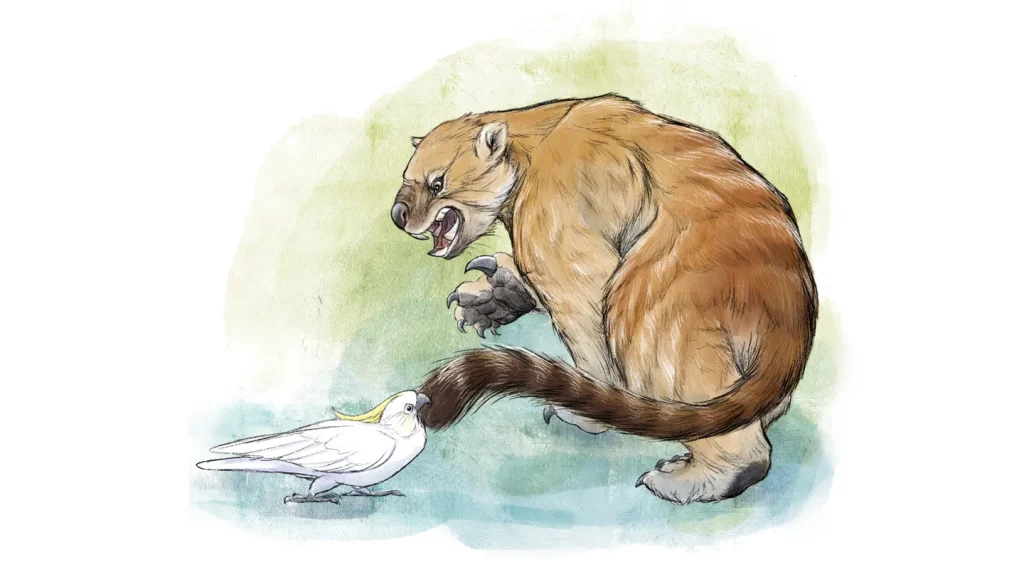From Cuddly Koalas to Terrifying Predators: Unveiling Marsupial Evolution
The koalas we adore today, peacefully munching eucalyptus leaves high in Australian canopies, harbor a surprising family secret. Their closest extinct relatives were not fellow plant-eaters, but fearsome carnivores known as marsupial lions that vanished from Earth around 40,000 years ago. This evolutionary revelation comes from groundbreaking research published in the Royal Society’s Proceedings B journal, where scientists used preserved proteins from ancient bones to reconstruct the evolutionary relationships of five mysterious extinct Australian marsupials. The findings have dramatically reshaped our understanding of how these unique mammals evolved and their connections to modern species.
Long before humans arrived in Australia, the continent was home to an astonishing array of giant marsupials – mammals that, unlike placental mammals, give birth to relatively underdeveloped young carried in a pouch. This megafauna included creatures like Zygomaturus trilobus (a massive wombat-like animal), kangaroos twice as tall as humans, and cow-sized, tapir-like herbivores such as Palorchestes azael. However, this diverse ecosystem experienced a catastrophic collapse shortly after human arrival, with approximately 90 percent of land animals heavier than 40 kilograms disappearing by around 46,000 years ago. For decades, paleontologists have debated the relationships between these extinct species and modern marsupials, relying primarily on bone shape analysis with inconclusive results. Michael Buckley, a biomolecular archaeologist from the University of Manchester, emphasizes that “before this work, the relationships between these animals were unclear, with several different possibilities proposed by various researchers.”
While ancient DNA typically helps scientists build evolutionary trees, it degrades rapidly over time – especially in Australia’s harsh climate. The research team, led by Buckley and Australian colleagues, turned to a more durable biological marker: collagen. This abundant structural protein persists in fossils long after DNA has broken down and, like DNA, contains species-specific variations that create a unique molecular fingerprint. The team sampled 51 marsupial bones from seven archaeological sites across Tasmania, dating from a few thousand to over 100,000 years ago. These remains belonged to eight species of both extinct and living marsupials. By extracting collagen and comparing amino acid sequences with those of modern species, they constructed the most accurate marsupial family tree to date. For three key extinct species – Zygomaturus trilobus, Palorchestes azael, and the predatory marsupial lion Thylacoleo carnifex – this study provided the first biomolecular insights into their ancestry, moving beyond traditional fossil analysis.
Some findings aligned with conventional wisdom. The collagen analysis confirmed that Zygomaturus and Palorchestes branched off from the same lineage as modern wombats and koalas, which previous fossil studies had suggested based on similar molar shapes and palate structures. However, the most startling discovery involved Thylacoleo – the fearsome marsupial lion. Michael Archer, a paleontologist at the University of New South Wales in Sydney, expressed surprise at the finding: “We’ve been chasing the evolution of marsupial lions. They’re saying it most closely matches koalas as opposed to wombats. So that’s a surprise.” Most researchers had previously placed Thylacoleo closer to wombats or outside both marsupial groups based on skull and tooth features. Instead, the protein analysis revealed that koalas and marsupial lions shared a common ancestor as recently as 23 million years ago – making them much closer relatives than anyone had suspected.
The contrast between today’s cuddly koalas and their fearsome extinct cousins is remarkable but not entirely surprising when examined closely. Thylacoleo could reach the size of a modern lion and possessed a powerful bite with bladelike teeth that functioned like biological bolt cutters. However, there are notable parallels between these predatory beasts and today’s seemingly harmless koalas. “Anybody who’s actually cuddled a koala knows they are not nice animals,” Archer points out. Modern koalas have sharp, gripping claws that can cause severe lacerations. Similarly, Thylacoleo was armed with enormous, curved claws on its thumbs. “When they grabbed prey and moved their hand around it, they would have unzipped the prey like a hot sausage,” explains Archer. This tree-dwelling predator was likely an adept climber that ambushed prey from above – ironically lending scientific credence to Australia’s folk legend of the “drop bear,” a supposedly mythical carnivorous koala that attacks from the canopy. “We actually have evidence here that Australian drop bears are not something that we dreamed up in a weird nightmare,” Archer notes with amusement.
The successful extraction and analysis of ancient proteins from these Tasmanian fossils opens exciting possibilities for future research. Tasmania’s relatively cool climate likely helped preserve the collagen in these remains, as the protein breaks down faster in hot environments. Carli Peters, a zooarchaeologist at the University of Algarve in Portugal, wonders how effectively these methods might work in “the more tropical, more arid regions of Australia.” She’s particularly interested in whether the approach could reveal new insights about Diprotodon, a rhino-sized herbivore that was the largest marsupial ever to roam the Earth. Buckley is optimistic about the broader applications of this technology, predicting that ancient protein sequences can and will be used to better understand the evolution of “a wide range of other extinct animals.” As scientists continue to refine these techniques, we may soon uncover even more surprising connections between the adorable modern marsupials we know today and their diverse, sometimes terrifying, ancestors.


